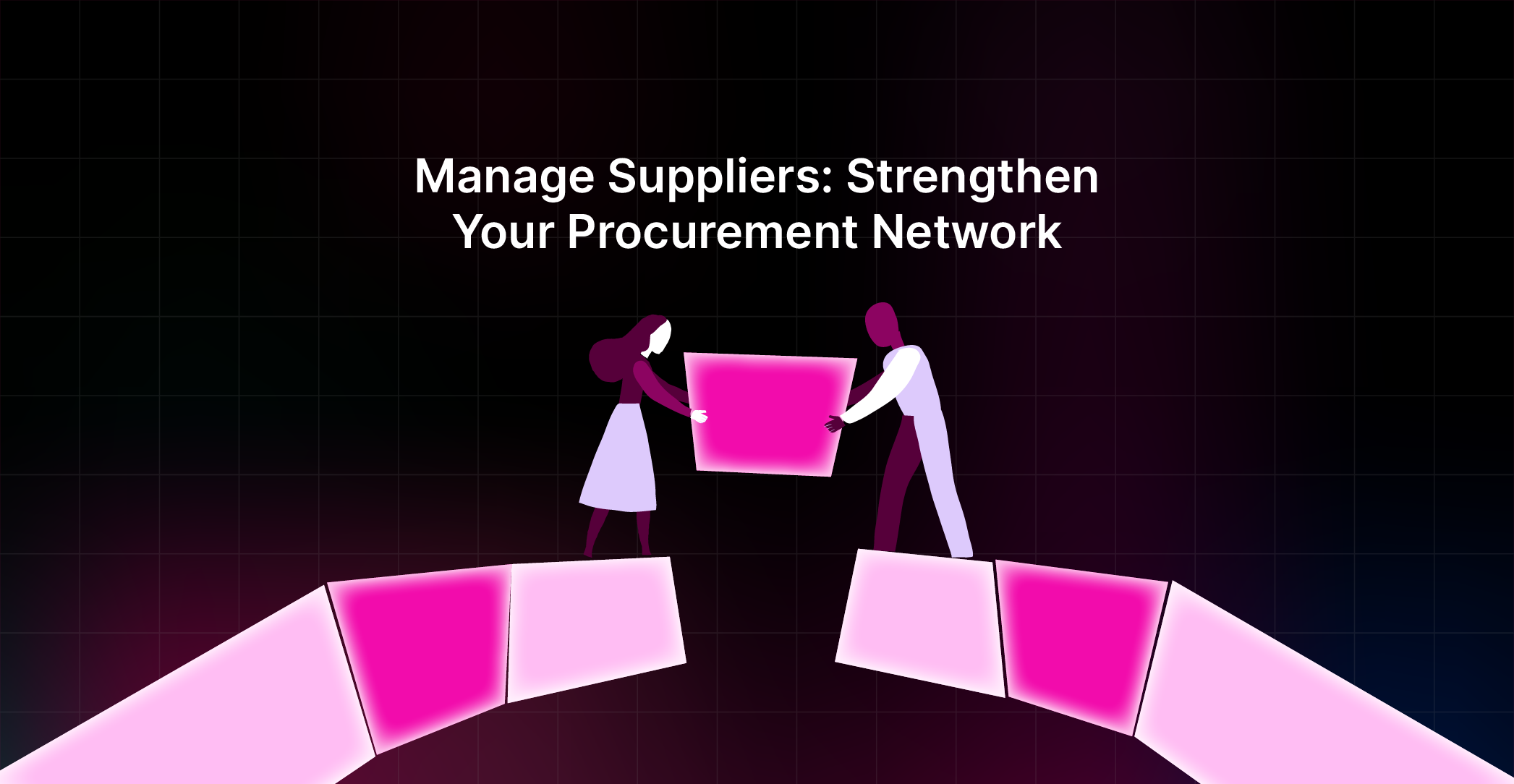


Cracking the code of savings: Your guide to SaaS spend optimization
Elevate cost-efficiency in SaaS operations. Learn tactics to optimize spend and enhance your bottom line effectively


Where technology drives operations, software-as-a-service (SaaS) has become an essential enabler of efficiency and innovation.
According to a market analysis report, the global SaaS market is projected to reach a compound annual growth rate (CAGR) of 13.7% from 2023 to 2030. This growth rate is explained by the rapid adoption of SaaS tools across industries.
However, the profusion of SaaS tools comes with a challenge: effectively managing SaaS expenses.
This blog post covers the following:
- Key strategies for SaaS spend optimization
- Best practices for long-term SaaS spend optimization
- Building a legit vendor management framework
- Overcoming resistance to SaaS spend optimization

Key strategies for SaaS spend optimization
Below are the key strategies to optimize SaaS spend:
Conduct a SaaS audit
Begin your optimization journey with a rigorous SaaS audit. This involves meticulously examining your organization's SaaS landscape to understand your subscriptions better.
During the audit, focus on the following aspects:
- Redundancies: Identify tools that offer similar functionalities and consider streamlining by retaining the most suitable one.
- Underutilized tools: Pinpoint subscriptions that need to be fully used or serve no purpose. Unsubscribing from such tools eliminates unnecessary costs.
- Opportunities for consolidation: Evaluate whether certain tools can be consolidated into a comprehensive platform. This not only saves costs but also simplifies management.
Negotiate favorable SaaS contracts
Contract negotiation helps you align with your actual usage needs and budget constraints.
But how?
- Usage-based pricing: Opt for pricing models that are based on your actual usage rather than fixed subscription tiers. This ensures you pay only for what you use.
- Flexible terms: Negotiate contract terms that allow for easy scaling up or down based on your evolving requirements. This prevents overcommitting and overspending.
- Discounts and incentives: Negotiate for volume discounts, especially if you have multiple subscriptions with the same vendor. Also, inquire about any loyalty or long-term commitment benefits.
Implement a SaaS management tool
Centralizing SaaS management strategy streamlines the procurement and usage of SaaS spend management software.
You can consider the following aspects to enhance visibility, control and compliance:
- Single procurement point: Channel all SaaS subscriptions through a single procurement point. This minimizes the chances of unauthorized purchases and enables better oversight.
- Standardized approval workflows: Implement standardized approval workflows for new SaaS subscriptions. This prevents ad-hoc purchases and ensures every subscription aligns with your strategy.
- Renewal tracking: Centralized management allows you to track renewal dates efficiently. This prevents auto-renewals of unnecessary tools and provides an opportunity for reevaluation.
Identify opportunities for consolidation
Tools with overlapping functionalities contribute to unnecessary complexities and costs.
Identify opportunities via the following steps:
- Functionality mapping: Create a map of the functionalities offered by each tool. Identify areas where multiple tools offer similar features.
- Suitable consolidation: Determine which tool among the duplicates is most suitable for your needs. Plan the migration process to ensure a seamless transition.
- User training: Communicate the consolidation plan to relevant teams and provide necessary training to ensure a smooth shift to the consolidated tool.
Track SaaS spend and budgeting
Real-time monitoring of SaaS spending is important to prevent overspending and allocate resources efficiently.
This strategy involves setting up tracking mechanisms and allocating budgets, such as:
- Real-time tracking: Use spend management software to monitor SaaS expenses in real time. This enables immediate action in case of unexpected spikes.
- Departmental budget allocation: Allocate SaaS budgets to different departments or teams based on their specific needs. This prevents one department from overspending at the expense of others.
- Regular review: Conduct periodic reviews of SaaS expenses and adjust budgets as needed. This ensures that your spending remains aligned with your organizational goals.
Best practices for long-term SaaS spend optimization
The journey to SaaS spend optimization demands a deliberate and strategic approach.
Below are some best practices to help you get started:
Continuous SaaS inventory management
SaaS spend optimization begins with meticulously examining your current SaaS portfolio.
- Regularly review the relevance and utility of subscribed tools.
- Remove redundant or underutilized applications that no longer align with your evolving business needs.
- Data-driven decision making
The foundation of intelligent SaaS spend optimization rests on data analytics.
- Use advanced analytical tools to derive insights from usage trends and performance metrics.
- Identify which tools are driving value and which might be redundant or overused.
Data-driven decision-making enables you to objectively evaluate the efficiency of your SaaS investments and determine where optimization efforts should be focused.
Strategic contract negotiation
The renewal of SaaS contracts presents a pivotal opportunity for optimization. Armed with usage data and insights, approach contract negotiations strategically.
Advocate for terms that genuinely align with your organization's requirements. This may involve scaling down licenses, adjusting subscription tiers or negotiating for cost reductions based on actual usage.
Such an approach ensures that your SaaS investments remain proportional to your operational needs.
Collaborative SaaS governance
Coherent SaaS spend optimization necessitates the involvement of stakeholders from diverse departments.
Adopt collaborative governance by engaging representatives from different teams in the decision-making process. This multifaceted approach ensures that the selected tools cater to various needs across the organization. It also fosters a sense of stakeholder ownership.
Regular performance evaluation
The dynamic nature of business operations demands continuous vigilance over the performance of SaaS spend management software.
- Regularly assess their impact on productivity, workflow efficiency and overarching business objectives.
- Identify areas where specific tools are excelling and where improvements are needed.
Building a legit vendor management framework
A systematic approach to vendor management helps achieve cost-effective SaaS spend and ensures seamless collaboration and adherence to business objectives.
To achieve this, consider the following essential components of a vendor management framework:
Vendor selection criteria
Start by outlining precise and strategic criteria for selecting SaaS vendors. Align these criteria with your organization's overarching goals and objectives. This step prevents the selection of vendors based solely on price, ensuring that chosen vendors provide solutions that cater to your unique operational needs.
Consider evaluating vendors based on factors such as reliability, scalability, security, customer support and alignment with your long-term business strategy.
Vendor onboarding process
The onboarding process sets the tone for your relationship with SaaS vendors. Streamline this process to ensure a smooth integration of new tools into your existing infrastructure.
Establish a clear and well-documented onboarding procedure that includes data migration, customization, user training and technical support steps. An onboarding process minimizes disruptions, accelerates the adoption of new tools and maximizes the benefits of your SaaS investments.
Vendor relationship management
Establish a proactive and transparent communication strategy to address concerns promptly and foster a collaborative partnership.
Regular check-ins, performance reviews and feedback sessions provide a mechanism to discuss issues, suggest improvements and ensure that the vendor's offerings continue to align with your evolving requirements.
Contractual agreements and SLAs
Your contracts should extend beyond mere pricing details and include exhaustive service-level agreements (SLAs). These SLAs must clearly outline the vendor's responsibilities, expected performance levels, response times and escalation procedures.
Pricing structures, terms for scaling or downsizing services and mechanisms for addressing unforeseen circumstances should also be detailed. Contracts provide a foundation for a transparent and mutually beneficial vendor-client relationship.
Risk assessment and reduction
Conduct assessments to identify risks associated with vendor performance, data security, compliance and continuity of service.
Develop contingency plans to address these risks, including alternative sourcing strategies, data recovery plans and steps to ensure minimal disruption in case of vendor-related challenges.
Regular monitoring and updates to risk assessment strategies enable proactive risk mitigation.
Overcoming resistance to SaaS spend optimization
When you attempt to implement a change, especially in areas like optimizing SaaS spend, you encounter resistance.
To ensure a smooth transition, adopt a targeted approach:
Identifying pain points and concerns
Begin by delving into your team's specific reservations about the optimization process. These could range from fears of disrupted workflow to uncertainties about the new tools. Addressing these concerns upfront equips you with tailored strategies to overcome resistance.
Communicating the benefits
Transparency is key in communicating how SaaS spend optimization benefits not only the organization as a whole but also individual teams and members.
Highlight the advantages of increased operational efficiency, more accurate budgeting and the empowerment of teams to align tools with their precise needs.
Addressing misconceptions and myths
A lack of clarity breeds misconceptions that hinder change. Use data-driven insights to substantiate the rationale behind the changes and assure the team of its feasibility.
Involving key stakeholders
Involving key stakeholders from various departments has two-fold benefits.
Firstly, it fosters a sense of collective ownership over the optimization process.
Secondly, it leverages the domain expertise of the stakeholders to tailor the strategy to each department's unique requirements.
Training and upskilling
Change is often met with resistance when teams are unfamiliar with the tools or processes being introduced. Provide inclusive training sessions that go beyond superficial orientations. Qualify your team with in-depth knowledge about the optimized SaaS landscape.
Measure your SaaS spend optimization success with Spendflo
Organizations striving to extract the utmost value from their digital investments must tactically oversee their SaaS expenditures. This approach isn't just about saving costs; it's about solving operational efficiencies and ensuring financial resilience.
Investing in spend management software like Spendflo helps you save up to 30% on your SaaS stack and get more visibility on your vendors. Spend less on every tool with our SaaS buying and optimization platform.
Get your free saving analysis with us today to learn more!















.png)










.avif)

.avif)
